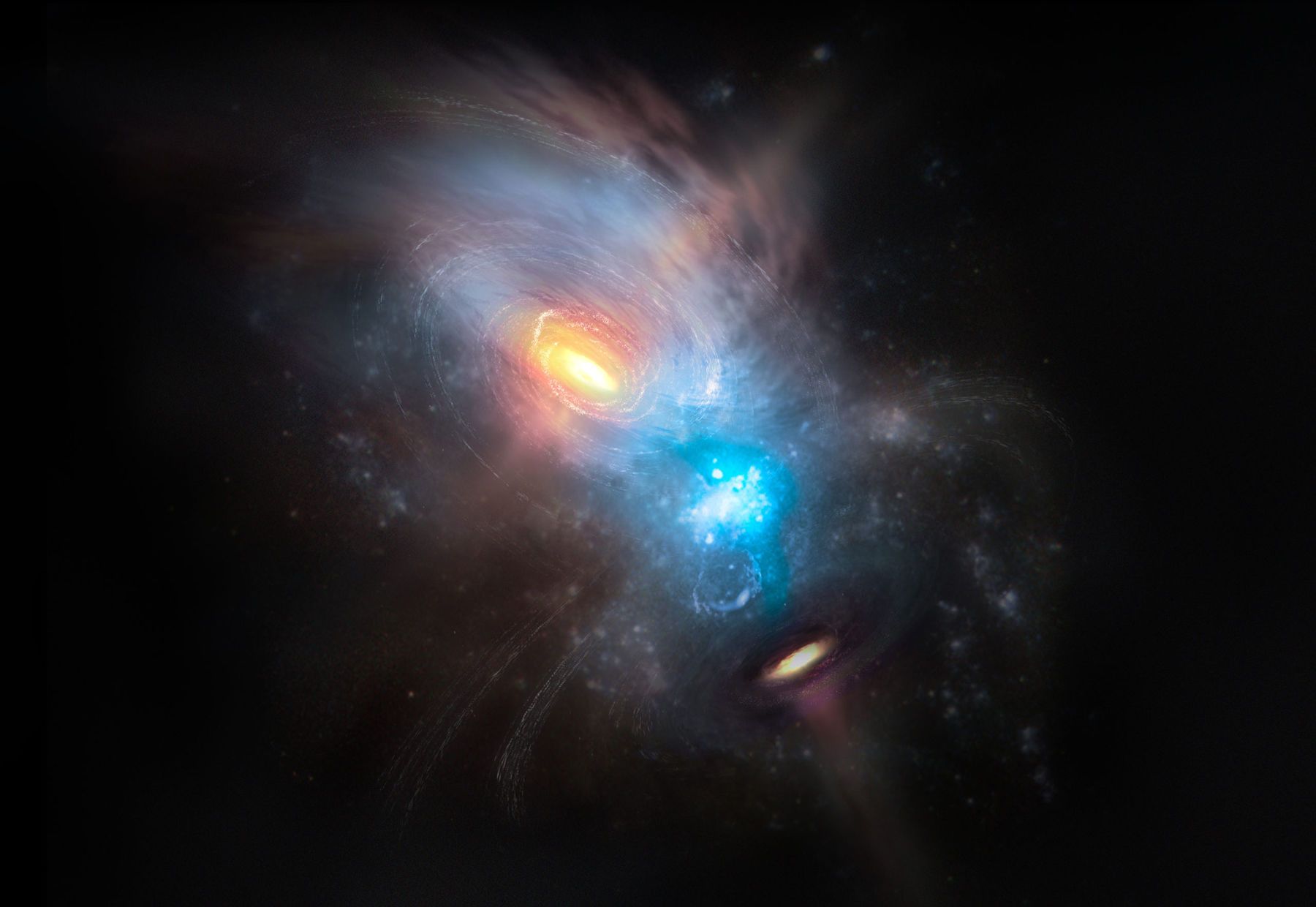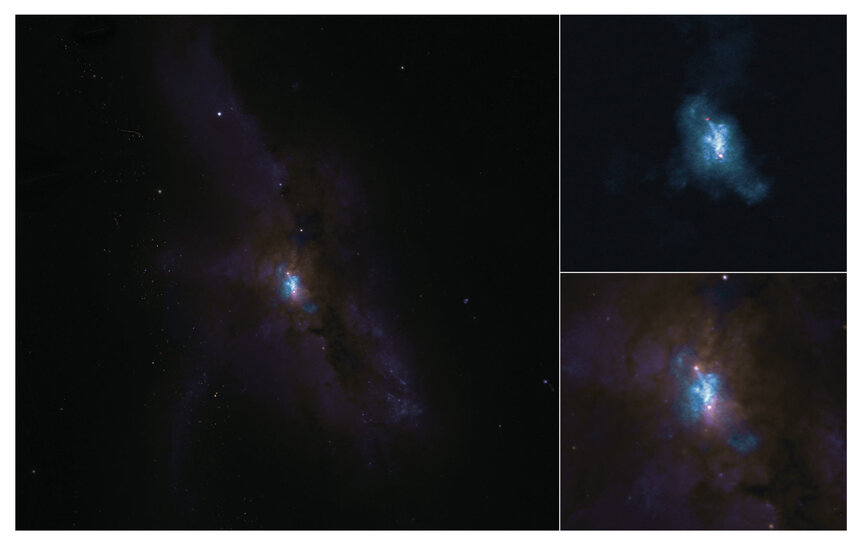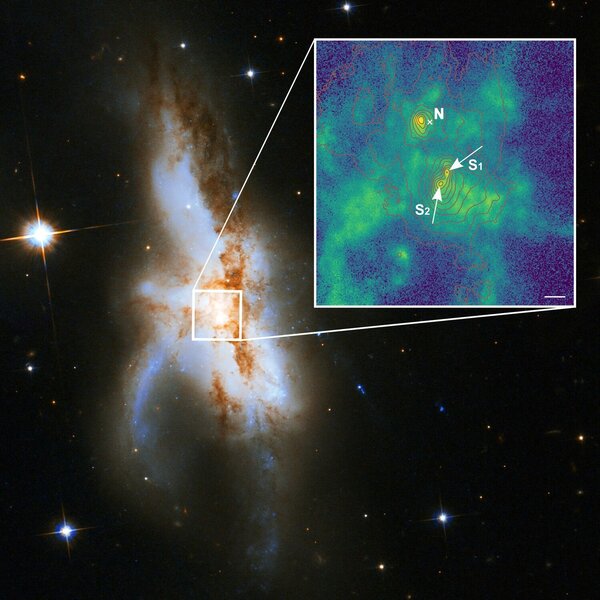Create a free profile to get unlimited access to exclusive videos, sweepstakes, and more!
Three supermassive black holes? In the galactic chaos of NGC 6240, ALMA sees just two

I recently wrote about NGC 6240, a collision between two galaxies where it looks like there were not two but three supermassive black holes seen in the observations. One of the two colliding galaxies had two bright spots in its core, which the astronomers interpreted as being two supermassive black holes.
New observations by another team of astronomers now cast some serious doubt on that. They show evidence for only two black holes there. If this is the case, it's not clear what that third object is, though they speculate it might be a very massive star cluster.
As a refresher, NGC 6240 is clearly a chaotic mess, typical of two massive galaxies in the throes of merging after a catastrophic collision. The process is far enough along that it’s difficult to distinguish one galaxy from the other in visible light images, though the evidence of a collision is obvious to the trained eye. Besides the jumbled up main mass, there are also tidal tails, streamers of stars pulled out by the mutual gravitational attraction of the two. These are a smoking gun for collisions.
Every big galaxy, we think, has a supermassive black hole in its core. In NGC 6240, both are clearly seen in high-resolution ground-based visible light images. One of the galaxies, though, appears to have two bright spots, which is what led the first group to assume they had found a third supermassive black hole, perhaps left over from a previous collision in one of the galaxies.
The new observations were made using ALMA, the Atacama Large Millimeter/submillimeter Array in Chile. At those wavelengths, far outside the range of the human eye, ALMA is sensitive to cold dust and gas in space. What they found is impressive: Vast amounts of molecular carbon monoxide gas in turbulent clouds between the two galactic nuclei where the two previously known black holes are.
The amount is incredible: Up to nearly ten billion times the mass of the Sun in just gas in that region! This gas forms a clumpy stream between the two nuclei. Previous, lower resolution images indicated that gas might be in a rotating disk, but the ALMA observations show this is not the case.
Much of this gas is close enough to the two black holes to be considered inside their "spheres of influence," possibly fated to fall in. The astronomers find one black hole has 750 million solar masses of gas around it, and the other a staggering 3.3 billion Suns' worth. That is a lot of gas.
It's also hauling gas (ha ha). Some of that material is seen to be moving at speeds up to 500 kilometers per second — fast enough to cross the diameter of our planet in less than 30 seconds — and it's not clear what accelerated it up to that speed.
That amount of gas is so substantial that it may have led to previous estimates of the black hole masses to be too high. The numbers I quoted above are for the gas close enough to the black holes to be possibly bound to them, capable of falling in. But telescopes can see even closer in to the black holes, and see the gas even nearer to them, only a couple of hundred light years out. There's a limit to how close in they can see, because ALMA can only resolve objects that are so close together. But at its resolution limit, they see 40–100 million solar masses of gas around the first black hole, and 120–770 million around the other. Earlier observations using visible light indicated these black holes have masses of at least 90 million times that of the Sun, so clearly the amount of gas there is high enough to be an issue. The black holes therefore may have much smaller masses once you account for that.
And this is why they doubt there's a third supermassive black hole there. They see no signs at all of third concentration of molecular gas, including at the location of the purported third black hole. Given that the other two that were previously known are positively soaking in this gas, it would be very peculiar to have a third one there with no gas at all around it. Peculiar enough that its existence is now very much in doubt.
That's OK, though. If that third object turns out to be a super star cluster and not a supermassive black hole, then we've still learned something new. And in either case these ALMA observations show that molecular gas plays a huge role in feeding black holes, and in fact is important to understand to get accurate measurements of just how big the black holes are.
Science is all about evidence, and sometimes that evidence supports your conclusion, and sometimes it doesn’t. New evidence can come along and change what we think, and in this case it’s pretty convincing to me. But who knows; maybe follow-up observations with yet another observatory will show this is more complicated than anyone thought.
It's clearly complicated now. But the fact remains that we can use our technology to observe these objects — over 300 million light years away — and peer into their cores to see the chaos there, and from that learn about what happens when two huge galaxies slam into each other. These collisions are one way galaxies grow, and happen pretty often… in fact, our Milky Way is slated to collide with the Andromeda Galaxy in 4.6 billion years! So when we look into MGC 6240, we may be seeing our own future, eons from now.





























